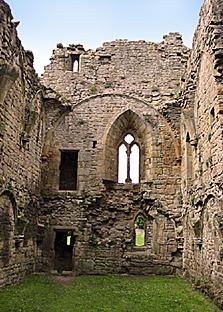| Fat geese, peace and quiet, and
medieval wall paintings I went to Easby in late August when, following heavy rain, the river was in spate and blackberries were ripening in the hedgerows. The fragrance of newly-mown grass hung in the still air and fat geese were enjoying the late afternoon sun. From the abbey one can see the keep of Richmond castle in the near distance; indeed, one can walk to it along the bank of the Swale. The ruined abbey, the Premonstratensian Abbey of St Agatha juxta Richmond, to give it its Sunday name, was founded in 1152 by the new order originated in France by St Norbert. This order of monks was not cloistered and cut off from the world but rather were priests who ministered to the people. They were known as White Canons because of their clothing and they were committed to a life of poverty, chastity, prayer and obedience. In these less pious and less insecure days today, it is not immediately easy to appreciate the contribution these good men made to the spiritual and physical welfare of the local people. On the whole the abbey enjoyed a quiet history. There were raids by the Scots and in 1346 an English army was billeted here on its way to the Battle of Neville’s Cross near Durham. The abbey was dissolved in 1536 by Henry VIII. Its contents were removed and, as elsewhere, its building left unroofed for the elements to do their worst. Now it survives only as a ruin reminding us of the social fabric and devotion of medieval England. Turner painted an evocative watercolour of the abbey in 1821.
|
|
Next to the abbey is St Agatha’s church, no ruin but an active church. St Agatha was martyred for her Christian faith in Sicily in the third century. Parts of the building are earlier but most of it dates from the twelfth and thirteenth centuries. It was restored in the nineteenth century by Sir George Gilbert Scott. There is a Norman font large enough to immerse an infant; it is decorated with arcading and stylised honeysuckle. In the medieval period churches had no pews; there is a wall bench for the frail – ‘the weak go to the wall’ derives from this.
Beyond the choir stalls is a copy of the Easby Cross, a Celtic cross dating from AD 790, which is decorated with representations of the apostles and a vine scroll in which are birds and animals. The original is in the Victoria and Albert Museum.
But the church’s greatest glory is the medieval wall paintings in the chancel which date from about 1250. These show scenes from the Old Testament, the life of Christ and aspects of medieval rural life. In one a sower is watched by a rook. In another a horseman has a falcon on his wrist. These were plastered over at the Reformation but are now wonderfully restored.
In the east window some medieval stained glass survives including a fifteenth century angel. A piscina near the altar was used for washing vessels used in the Mass and there are three sedilia, seats for priests, each with a medieval painting of a cleric. The piscina and sedilia are in the Early English style and there is Perpendicular woodwork in the church too.
Grooves in the stone by the church door were made by archers sharpening their arrows. In the churchyard are headstones dating back centuries.
The church still uses the 1662 Book of Common Prayer (see www.prayerbook.org.uk), not the modern ‘relevant’ services.
There was an earlier Saxon church here. Paulinus baptised converts in the Swale near here in the seventh century before England was a nation.
The abbey and church are not well-known and outside the standard tourist trail. Their site is magnificent, they ooze England’s history and are a place of great peace. They are cared for by English Heritage and the parishioners. This is one of Yorkshire’s hidden treasures.
